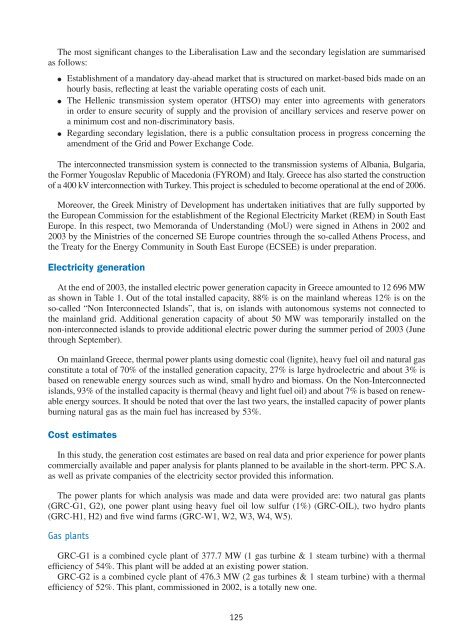Projected Costs of Generating Electricity - OECD Nuclear Energy ...
Projected Costs of Generating Electricity - OECD Nuclear Energy ...
Projected Costs of Generating Electricity - OECD Nuclear Energy ...
You also want an ePaper? Increase the reach of your titles
YUMPU automatically turns print PDFs into web optimized ePapers that Google loves.
The most significant changes to the Liberalisation Law and the secondary legislation are summarised<br />
as follows:<br />
●<br />
●<br />
●<br />
Establishment <strong>of</strong> a mandatory day-ahead market that is structured on market-based bids made on an<br />
hourly basis, reflecting at least the variable operating costs <strong>of</strong> each unit.<br />
The Hellenic transmission system operator (HTSO) may enter into agreements with generators<br />
in order to ensure security <strong>of</strong> supply and the provision <strong>of</strong> ancillary services and reserve power on<br />
a minimum cost and non-discriminatory basis.<br />
Regarding secondary legislation, there is a public consultation process in progress concerning the<br />
amendment <strong>of</strong> the Grid and Power Exchange Code.<br />
The interconnected transmission system is connected to the transmission systems <strong>of</strong> Albania, Bulgaria,<br />
the Former Yougoslav Republic <strong>of</strong> Macedonia (FYROM) and Italy. Greece has also started the construction<br />
<strong>of</strong> a 400 kV interconnection with Turkey. This project is scheduled to become operational at the end <strong>of</strong> 2006.<br />
Moreover, the Greek Ministry <strong>of</strong> Development has undertaken initiatives that are fully supported by<br />
the European Commission for the establishment <strong>of</strong> the Regional <strong>Electricity</strong> Market (REM) in South East<br />
Europe. In this respect, two Memoranda <strong>of</strong> Understanding (MoU) were signed in Athens in 2002 and<br />
2003 by the Ministries <strong>of</strong> the concerned SE Europe countries through the so-called Athens Process, and<br />
the Treaty for the <strong>Energy</strong> Community in South East Europe (ECSEE) is under preparation.<br />
<strong>Electricity</strong> generation<br />
At the end <strong>of</strong> 2003, the installed electric power generation capacity in Greece amounted to 12 696 MW<br />
as shown in Table 1. Out <strong>of</strong> the total installed capacity, 88% is on the mainland whereas 12% is on the<br />
so-called “Non Interconnected Islands”, that is, on islands with autonomous systems not connected to<br />
the mainland grid. Additional generation capacity <strong>of</strong> about 50 MW was temporarily installed on the<br />
non-interconnected islands to provide additional electric power during the summer period <strong>of</strong> 2003 (June<br />
through September).<br />
On mainland Greece, thermal power plants using domestic coal (lignite), heavy fuel oil and natural gas<br />
constitute a total <strong>of</strong> 70% <strong>of</strong> the installed generation capacity, 27% is large hydroelectric and about 3% is<br />
based on renewable energy sources such as wind, small hydro and biomass. On the Non-Interconnected<br />
islands, 93% <strong>of</strong> the installed capacity is thermal (heavy and light fuel oil) and about 7% is based on renewable<br />
energy sources. It should be noted that over the last two years, the installed capacity <strong>of</strong> power plants<br />
burning natural gas as the main fuel has increased by 53%.<br />
Cost estimates<br />
In this study, the generation cost estimates are based on real data and prior experience for power plants<br />
commercially available and paper analysis for plants planned to be available in the short-term. PPC S.A.<br />
as well as private companies <strong>of</strong> the electricity sector provided this information.<br />
The power plants for which analysis was made and data were provided are: two natural gas plants<br />
(GRC-G1, G2), one power plant using heavy fuel oil low sulfur (1%) (GRC-OIL), two hydro plants<br />
(GRC-H1, H2) and five wind farms (GRC-W1, W2, W3, W4, W5).<br />
Gas plants<br />
GRC-G1 is a combined cycle plant <strong>of</strong> 377.7 MW (1 gas turbine & 1 steam turbine) with a thermal<br />
efficiency <strong>of</strong> 54%. This plant will be added at an existing power station.<br />
GRC-G2 is a combined cycle plant <strong>of</strong> 476.3 MW (2 gas turbines & 1 steam turbine) with a thermal<br />
efficiency <strong>of</strong> 52%. This plant, commissioned in 2002, is a totally new one.<br />
125

















